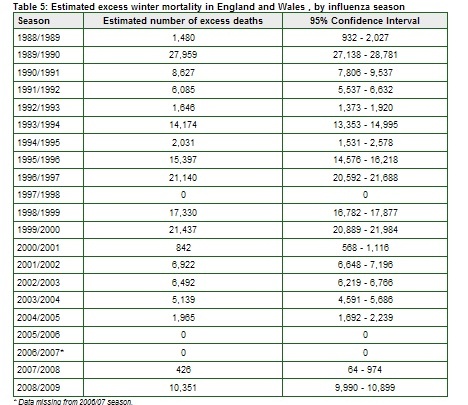Flu Deaths Per Year
'Ranges like 2,000 to 4,000 or even 8,000 influenza-related deaths a year are thrown around each flu season, and policy decisions and flu shot campaigns are based on these numbers,' Michael Gardam. Between 1979 and 2002, NCHS data show an average 1348 flu deaths per year (range 257 to 3006). The NCHS data would be compatible with CDC mortality estimates if about half of the deaths classed by the NCHS as pneumonia were actually flu initiated secondary pneumonias.
- Flu Deaths Per Year Usa 2019
- Flu Vs. Coronavirus (COVID-19): Mortality Rates And Deaths ...
- Flu Deaths Reality Check
Reviewed By:
Influenza (the flu) and COVID-19, the illness caused by the pandemic coronavirus, are both contagious respiratory illnesses, meaning they affect your lungs and breathing, and can be spread to others. Although the symptoms of COVID-19 and the flu can look similar, the two illnesses are caused by different viruses.
Lisa Maragakis, M.D., M.P.H., senior director of infection prevention at Johns Hopkins, explains how the flu and COVID-19 are similar and how they are different.
Similarities: COVID-19 and the Flu
Symptoms


- Both illnesses can cause fever, cough, body aches, and sometimes vomiting and diarrhea (especially in children). Learn more about COVID-19 symptoms.
- Both can result in pneumonia.
- Both flu and COVID-19 can be mild or severe, or even fatal in rare cases.
How It Spreads
Flu Deaths Per Year Usa 2019
- Both the flu and COVID-19 spread in similar ways. Droplets or smaller virus particles from a sick person can transmit the virus to other people nearby. The smallest particles may linger in the air, and another person can inhale them and become infected.
- Or, people can touch a surface with viruses on it, and then transfer the germs to themselves by touching their face.
- People infected with the coronavirus or the flu may not realize they are sick for several days, and during that time can unknowingly spread the disease to others before they even feel sick.
Treatment
- Neither the flu nor COVID-19 is treatable with antibiotics, which only work on bacterial infections.
- Both are treated by addressing symptoms, such as reducing fever. Severe cases may require hospitalization and very ill patients may need a ventilator — a machine that helps them breathe.
- Antiviral medications may shorten the duration of both illnesses.


Prevention
Both can be prevented by mask-wearing, frequent and thorough hand washing, coughing into the crook of your elbow, staying home when sick and limiting contact with people who are infected. Physical distancing limits the spread of COVID-19 in communities.
Flu Prevention During Coronavirus Pandemic: Infographic
Fall and winter months bring the flu season. Here is what you need to know to help protect you and your family from the flu and COVID-19.
Differences: COVID-19 and the Flu
Cause
COVID-19: Caused by the 2019 coronavirus, also known as SARS-CoV-2.
Flu: Caused by any of several different types and strains of influenza viruses. Different strains circulate each year.
Symptoms
COVID-19: Many people infected with the coronavirus do not feel sick or have any symptoms at all, but they can still transmit the coronavirus to other people. Review the full list of symptoms.
Unlike the flu, COVID-19 can sometimes cause a person to suddenly lose their sense of smell (anosmia) or taste (ageusia).
Flu: Flu does not typically affect a person’s sense of smell or taste.
Treatment
COVID-19: Antiviral medications and other therapies are being tested to see if they can effectively address symptoms and shorten the duration of the illness. Currently, effective treatments are only available in an intravenous form, so they are not prescribed to patients outside of a hospital setting.
Flu: Oral antiviral medications can address symptoms and sometimes shorten the duration of the illness. Because they are given by mouth, these antiviral therapies can be prescribed for patients who are not hospitalized as well as for those in the hospital.
Vaccine
COVID-19: The first COVID-19 vaccines have been authorized for emergency use and vaccination programs are in progress.
Flu: A vaccine is available and effective in preventing some of the most dangerous types or to reduce the severity or duration of the flu. It is very important to get vaccinated for the flu this year.
Flu and COVID-19: Similarities and Differences
Complications
COVID-19: Complications including long-term damage to the lungs, heart, kidneys, brain and other organs is possible after a severe case of COVID-19.
Flu: Influenza complications can include inflammation of the heart (myocarditis), brain (encephalitis) or muscles (myositis, rhabdomyolysis), and multi-organ failure. Secondary bacterial infections sometimes occur following a bout of influenza infection.
Infections
COVID-19: The first cases appeared in China in late 2019, and the first confirmed case in the United States appeared in January 2020.
Approximately 143,962,157 cases have been confirmed worldwide. There have been 31,862,987 cases in the U.S. between January 2020 and April 22, 2021.*
Flu: The World Health Organization estimates that 1 billion people worldwide get the flu every year.
In the U.S., for Oct. 1, 2019–Apr. 4, 2020, the Centers for Disease Control and Prevention (CDC) estimates that there were 39 million to 56 million cases of flu. (The CDC does not know the exact number because the flu is not a reportable disease in most parts of the U.S.)
Flu Season and the Coronavirus: How to Prepare
Infectious disease expert Lisa Maragakis offers insights on what to keep in mind as you prepare for the fall and winter flu season.
Coronavirus vs. Flu Deaths
COVID-19: There have been approximately 3,061,478 deaths reported worldwide. In the U.S, 569,404 people have died of COVID-19 between January 2020 and April 22, 2021.*
Flu: The World Health Organization estimates that 290,000 to 650,000 people die of flu-related causes every year worldwide.
The COVID-19 situation is changing rapidly. Since this disease is caused by a new virus, the vast majority of people do not yet have immunity to it, and a vaccine may be many months away. Doctors and scientists are working to estimate the mortality rate of COVID-19, but at present, it is thought to be substantially higher (possibly 10 times or more) than that of most strains of the flu.
*This information comes from the Coronavirus COVID-19 Global Cases map developed by the Johns Hopkins Center for Systems Science and Engineering.

Flu Vs. Coronavirus (COVID-19): Mortality Rates And Deaths ...
Coronavirus (COVID-19) Email Alerts
Sign up to receive coronavirus (COVID-19) email updates from Johns Hopkins Medicine.Flu Deaths Reality Check
